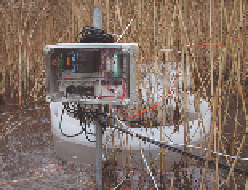Geoscience Reference
In-Depth Information
Denmark
The United Kingdom
Switzerland
Figure 6.4
Experimental mesocosm facilities set-up in Denmark, the United Kingdom
and Switzerland to study the combined effects of warming and nutrient enrichment on
freshwater ecosystems.
Experimental tanks in the United Kingdom
Two experiments have been carried out in a system of forty-eight 3-m
3
tanks near
Liverpool in north-west England. Mesocosms mimicking ponds and shallow
lakes were warmed by a pumped hot-water system (McKee
et al
. 2000, Fig. 6.2).
The first, in 1998-2000, used planted macrophyte communities, including
Lagarosiphon major, Elodea nuttallii
and
Potamogeton natans
, a 3 °C rise in
temperature above ambient, rather infertile inorganic sediments and a fertilization
regime in which concentrations given were 0.5 mg N l
−1
and 0.05 mg P l
−1
,
compared with controls in which no nutrients were applied. Sticklebacks
(
Gasterosteus aculeatus
) were present in half of the mesocosms, which were set
up in a randomized block design with quadruple replication.
The second experiment, in 2005-7, involved a temperature increase of 4 °C
above ambient, presence and absence of sticklebacks and three nutrient regimes
in mesocosms that had sediments higher in organic matter and nutrients (loss on
ignition 7.5%, TN 0.83 mg g
−1
and TP 0.2 mg g
−1
) than in the previous experiment.
Controls with no additions of nutrients constituted the first regime, the second
used a lower (0.25 mg N l
−1
) level and the third a higher (2.5 mg N l
−1
) level than
in the first experiment, in line with the loadings on waters in regions with
intensive agriculture. Only a small phosphorus dose was given, because the tanks
were phosphorus rich as a result of release from sediment. The plant community
was self-determined from seed and fragments and dominated by the submerged
E. nuttallii
and
Ceratophyllum demersum
and the free-floating
Lemna trisulca
,
together with other floating lemnids (
Lemna minor, Spirodela polyrhiza
). Absolute
maximum ambient temperatures in the summers of 1999 and 2000 were 23.7 °C
and 24.8 °C, respectively. Ambient summer means were 16.4 °C and 15.5 °C
(McKee
et al
. 2003). In the second experiment, in 2007, the summer ambient
maximum was 24.9 °C and the summer mean, 15.5 °C.
In the first experiment (McKee
et al
. 2002, 2003), warming did not change
phytoplankton biomass, even with increased nutrients and fish presence.
Macrophyte communities remained dominant. Total plant abundance remained
relatively high and was unaffected by warming, but the proportion of an exotic
species,
L. major
, introduced from South Africa, increased. Warming had no
influence on
E. nuttallii
, a result observed again in the later experiment.






























Search WWH ::

Custom Search